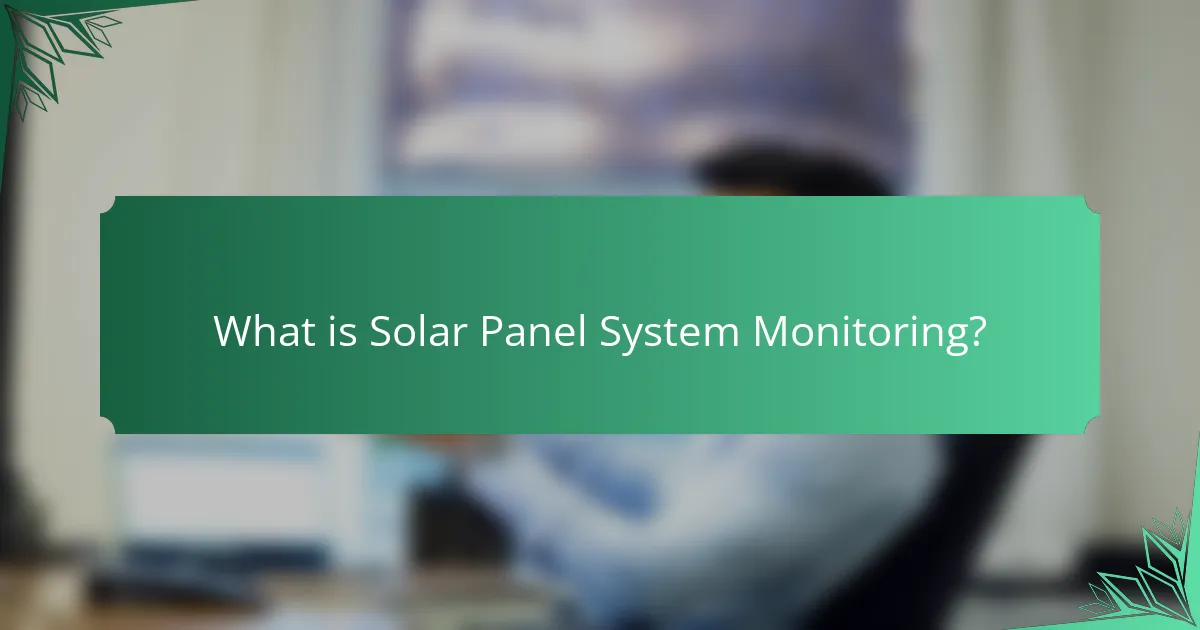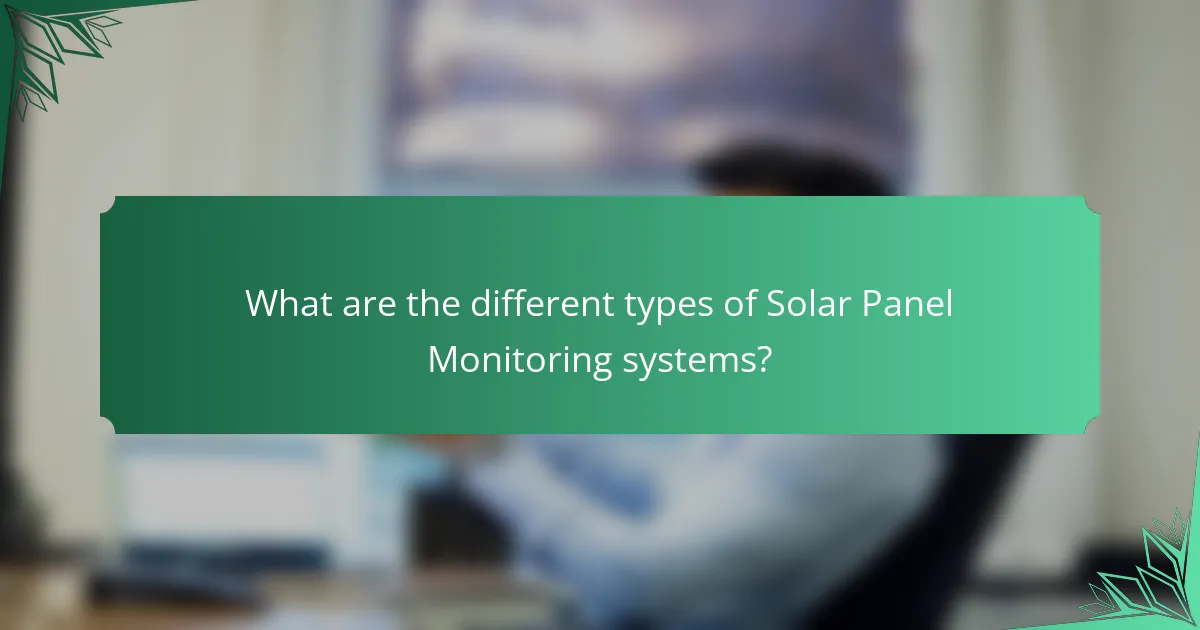
What is Solar Panel System Monitoring?
Solar panel system monitoring is the process of tracking the performance of solar energy systems. It involves collecting data on energy production, system efficiency, and operational status. Monitoring helps identify issues such as equipment malfunctions or underperformance. Real-time data allows for timely maintenance and repairs. Effective monitoring can increase the overall efficiency of solar systems. According to the U.S. Department of Energy, regular monitoring can enhance energy production by up to 20%. This data-driven approach ensures optimal functioning and maximizes return on investment.
How does Solar Panel System Monitoring work?
Solar panel system monitoring works by tracking the performance and efficiency of solar energy systems. It utilizes sensors and software to collect data on energy production and system health. Monitoring systems can detect issues such as shading, dirt accumulation, or equipment failures. This data is transmitted to a central platform for analysis. Users can access real-time information through web or mobile applications. Alerts are generated for any anomalies or performance drops. Regular monitoring helps optimize energy production and prolong system lifespan. According to the National Renewable Energy Laboratory, effective monitoring can increase solar energy output by 10% to 30%.
What are the key components of a Solar Panel Monitoring system?
The key components of a Solar Panel Monitoring system include sensors, data loggers, communication devices, and software interfaces. Sensors collect real-time data on solar panel performance, such as energy production and environmental conditions. Data loggers store this information for analysis and reporting. Communication devices transmit data to remote servers or user interfaces, enabling access from various locations. Software interfaces allow users to visualize data and generate reports. These components work together to ensure optimal performance and efficiency of solar panel systems.
How do data collection and analysis play a role in monitoring?
Data collection and analysis are crucial for effective monitoring. They enable the tracking of performance metrics over time. In solar panel systems, data collection involves gathering information on energy production, weather conditions, and system health. This data is analyzed to identify trends and anomalies. For instance, consistent data analysis can reveal underperformance due to shading or equipment issues. Accurate monitoring relies on this continuous feedback loop. Research indicates that systems with robust monitoring can improve efficiency by up to 20% (Solar Energy Industries Association, 2021). Thus, data collection and analysis directly enhance the operational efficiency of solar panel systems.
Why is Solar Panel System Monitoring important for efficiency?
Solar panel system monitoring is crucial for maintaining efficiency. It allows for real-time tracking of energy production and system performance. Monitoring identifies issues such as malfunctions or inefficiencies quickly. For example, a study by the National Renewable Energy Laboratory found that regular monitoring can improve system performance by up to 20%. This helps ensure optimal energy output and reduces downtime. Moreover, monitoring provides data that can inform maintenance schedules. This proactive approach minimizes long-term costs and maximizes energy savings. Overall, effective monitoring leads to enhanced solar energy efficiency and reliability.
What impact does monitoring have on energy production?
Monitoring significantly enhances energy production. It allows for real-time tracking of solar panel performance. By identifying underperforming panels, maintenance can be promptly scheduled. This leads to increased energy output and efficiency. Studies show that systems with monitoring can produce up to 30% more energy. Monitoring also helps in detecting environmental impacts, such as shading or dirt accumulation. This ensures optimal performance throughout the solar panel’s lifespan. Overall, effective monitoring is crucial for maximizing energy production in solar systems.
How can monitoring prevent potential system failures?
Monitoring can prevent potential system failures by providing real-time data on system performance. It allows for the early detection of irregularities or performance drops. Identifying issues quickly can lead to timely maintenance or repairs. Regular monitoring helps in analyzing trends over time. This analysis can reveal patterns that indicate impending failures. For instance, a drop in energy output may signal a malfunctioning component. According to a study by the National Renewable Energy Laboratory, proactive monitoring can reduce system downtime by up to 30%. This reduction in downtime enhances overall system efficiency and lifespan.

What are the different types of Solar Panel Monitoring systems?
There are several types of solar panel monitoring systems. The main types include string monitoring, module-level monitoring, and system-level monitoring.
String monitoring tracks the performance of solar panel strings. This type provides data on the overall output of multiple panels connected in series. Module-level monitoring monitors individual panels. It allows for detailed analysis of each panel’s performance, identifying specific issues.
System-level monitoring assesses the entire solar energy system. This includes inverters, batteries, and other components. It provides a comprehensive view of the system’s efficiency.
Each type of monitoring system offers unique insights. String monitoring is simpler but less detailed. Module-level monitoring is more precise but can be more complex. System-level monitoring gives an overview but may miss individual panel issues.
These systems help optimize energy production and maintenance. Accurate monitoring can increase efficiency by up to 30%.
How do remote monitoring systems function?
Remote monitoring systems function by collecting data from various sensors and devices. These systems use wireless technology to transmit data to a central server. The server processes the data and provides real-time insights. Users can access this information through a web interface or mobile application. Remote monitoring systems often include alerts for anomalies or performance issues. This allows for timely intervention and maintenance. Research shows that effective monitoring can improve efficiency by up to 30%. This data-driven approach ensures optimal performance of solar panel systems.
What technologies are used in remote monitoring?
Remote monitoring technologies include IoT devices, sensors, and cloud computing. IoT devices collect real-time data from solar panels. Sensors measure performance metrics such as energy output and temperature. Cloud computing platforms store and analyze this data. Mobile applications provide users with access to monitoring information. Communication protocols like MQTT and HTTP facilitate data transmission. These technologies enable efficient management of solar panel systems. According to a report by MarketsandMarkets, the IoT in energy management is expected to grow significantly, highlighting the importance of these technologies.
What are the benefits of using remote monitoring systems?
Remote monitoring systems enhance efficiency by providing real-time data access. They allow users to track performance and identify issues promptly. This leads to quicker maintenance responses and reduced downtime. According to a study by the National Renewable Energy Laboratory, systems with monitoring can improve energy production by up to 20%. Additionally, remote monitoring can optimize energy usage by analyzing consumption patterns. It also facilitates remote diagnostics, minimizing the need for on-site visits. Overall, these systems contribute to cost savings and improved operational performance in solar panel systems.
What are the advantages of real-time monitoring?
Real-time monitoring provides immediate insights into solar panel system performance. It allows for quick identification of issues, ensuring timely maintenance. This leads to increased efficiency and optimal energy production. Real-time data helps in analyzing performance trends over time. It also supports better decision-making regarding system upgrades or changes. According to a study by the National Renewable Energy Laboratory, systems with monitoring can improve energy output by up to 15%. This highlights the significant benefits of implementing real-time monitoring in solar energy systems.
How does real-time data enhance system performance?
Real-time data enhances system performance by providing immediate insights into operational efficiency. This data allows for quick identification of issues such as underperformance or faults. For example, solar panel systems can adjust to changes in sunlight and weather conditions instantly. A study by the National Renewable Energy Laboratory found that real-time monitoring can improve energy output by up to 20%. Timely data enables proactive maintenance, reducing downtime and increasing overall efficiency. Furthermore, real-time analytics help optimize energy consumption based on current demand. This leads to better resource allocation and improved system reliability.
What are the cost savings associated with real-time monitoring?
Real-time monitoring of solar panel systems leads to significant cost savings. It allows for immediate detection of issues, preventing costly repairs and downtime. According to a study by the National Renewable Energy Laboratory, real-time monitoring can reduce maintenance costs by up to 30%. This proactive approach minimizes energy loss, ensuring optimal performance and maximizing returns on investment. Furthermore, it can extend the lifespan of the solar panels by identifying problems early. Overall, these factors contribute to a more efficient and cost-effective solar energy system.

What best practices should be followed for effective Solar Panel Monitoring?
Effective solar panel monitoring involves regular performance assessments, data logging, and timely maintenance. Regular performance assessments help identify inefficiencies and ensure optimal energy production. Data logging allows for tracking energy output and identifying trends over time. Timely maintenance, including cleaning panels and checking connections, prevents performance degradation. Utilizing monitoring software provides real-time data and alerts for any issues. Additionally, setting performance benchmarks helps to measure system efficiency against expected outputs. Research indicates that systems with effective monitoring can increase energy production by up to 20%.
How can regular maintenance improve monitoring effectiveness?
Regular maintenance enhances monitoring effectiveness by ensuring that solar panel systems operate at optimal performance levels. Well-maintained systems experience fewer malfunctions, which allows monitoring tools to provide accurate data. This accuracy is crucial for identifying issues early, leading to timely interventions. Regular checks can also calibrate monitoring equipment, ensuring precise readings. According to the National Renewable Energy Laboratory, systems with routine maintenance can achieve up to 20% more efficiency. Additionally, maintenance helps in cleaning panels, which directly impacts energy production and monitoring data reliability.
What specific maintenance tasks should be performed regularly?
Regular maintenance tasks for solar panel systems include cleaning the panels, inspecting for damage, and checking electrical connections. Cleaning panels removes dirt and debris that can block sunlight. Inspections help identify cracks or loose fittings. Checking electrical connections ensures optimal performance and safety. These tasks should be performed at least twice a year. Studies show that regular maintenance can increase energy efficiency by up to 20%.
How often should monitoring data be reviewed for optimal performance?
Monitoring data should be reviewed at least monthly for optimal performance. Regular monthly reviews allow for timely identification of issues. This frequency helps ensure that any performance drops are addressed quickly. Research shows that consistent monitoring can increase energy output by up to 15%. Monthly assessments help in maintaining system efficiency and longevity. Additionally, quarterly reviews can provide deeper insights into performance trends. This combination of monthly and quarterly reviews maximizes overall system effectiveness.
What common issues can be identified through monitoring?
Common issues identified through monitoring solar panel systems include performance degradation, shading effects, and equipment malfunctions. Performance degradation can occur due to dust accumulation or aging components. Shading effects reduce energy output when objects block sunlight. Equipment malfunctions may involve inverter failures or wiring issues. Monitoring systems can detect these problems early. Early detection allows for timely maintenance and repairs. This ensures optimal energy production and system efficiency. Regular monitoring significantly enhances the longevity of solar installations.
How can monitoring help detect shading problems?
Monitoring can help detect shading problems by providing real-time data on solar panel performance. This data reveals discrepancies in energy output that may indicate shading issues. For instance, a sudden drop in output from a specific panel can signal that it is being shaded. Monitoring systems can also compare performance across multiple panels. This comparison helps identify patterns that suggest shading from nearby objects. Additionally, many monitoring systems use infrared cameras to visualize shading effects. This technology can pinpoint the exact areas affected by shading. Studies show that early detection of shading issues can improve overall system efficiency by up to 20%. Thus, consistent monitoring is crucial for maintaining optimal solar panel performance.
What role does monitoring play in identifying inverter issues?
Monitoring plays a critical role in identifying inverter issues. It allows for real-time data collection on the inverter’s performance. This data includes metrics like voltage, current, and energy output. By analyzing these metrics, discrepancies can be detected quickly. For example, a drop in energy output may indicate an inverter malfunction. Regular monitoring can also reveal patterns over time, helping to predict potential failures. Studies show that proactive monitoring can reduce downtime by up to 30%. This efficiency is vital for maximizing solar energy production.
What practical tips can enhance Solar Panel System Monitoring?
Utilizing advanced monitoring software can enhance solar panel system monitoring. This software provides real-time data on energy production and system performance. Regularly checking the system’s output helps identify any discrepancies. Installing weather sensors can improve monitoring accuracy by correlating energy output with environmental conditions. Setting up alerts for performance issues ensures timely responses to potential problems. Conducting periodic maintenance checks keeps the system operating efficiently. Engaging with professional monitoring services offers expert insights and support. These practices collectively contribute to optimizing solar energy efficiency.
The main entity of this article is Solar Panel System Monitoring, which is essential for tracking the performance and efficiency of solar energy systems. The article outlines how monitoring works, its key components, and the importance of data collection and analysis in identifying issues and optimizing energy production. It discusses the various types of monitoring systems, the role of remote technologies, and the benefits of real-time monitoring for enhancing operational efficiency. Additionally, it highlights best practices for effective monitoring, including regular maintenance and data review, to maximize the efficiency and longevity of solar panel systems.